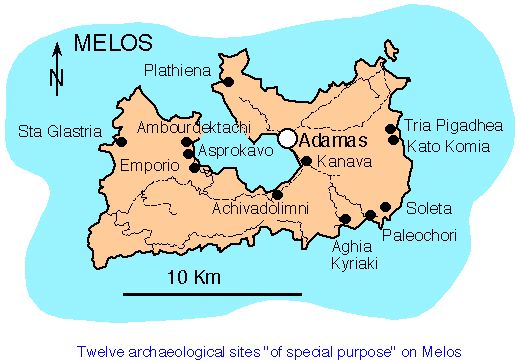Melos
Melos

In the late 1890s while excavating at Phylakopi on the north-eastern coast of Melos, Duncan McKenzie identified a number of sites in the SE of the island dating to the Classical/Roman period. These sites could have been involved in the processing and packaging of industrial minerals. The same sites were characterised as sites of ‘special purpose’ (see above figure) by Cherry and his team as part of the field work on the island in the late 1970s (see J. Cherry in C. Renfrew & M. Wagstaff (eds.) 1982 An Island Polity: the Archaeology of Exploitation in Melos).
The aim of our Melos project is to establish the nature, origin, sources, mining and production methods, uses and socio-economic significance of Melian industrial minerals in antiquity.
Melos is currently one of the world's major producers of bentonite, an absorbent clay which has a multitude of modern applications from the iron industry to cosmetics and pharmaceuticals. It is better known by the name of fuller's earth and was used for degreasing of wool. Many other industrial minerals have been produced from Melos but we have concentrated on three: alumen ( alum), sulphur and so-called 'Melian earth'.
Given the elusive nature of these minerals, the project required the development of a research approach, different to that applied to the mining and processing of metals, with particular emphasis on the understanding of the geothermal processes on the island. All three industrial minerals exploited in antiquity were the result of such activity.
In order to investigate the nature and distribution of these minerals on Melos and to expore the archaeological remains associated with their exploitation, we have carried out a geoarchaeological survey in the SE district of the island, in particular in the Ag. Kyriaki area.
Melos Project History
1996: PhD project initiated.
McNulty, Arbory E. Industrial Minerals in Antiquity: Melos in the Classical and Roman Periods. Unpubl. PhD. Thesis. 2000. Department of Archaeology and Division of Earth Sciences. University of Glasgow.
1998: Aghia Kyriaki Survey, Melos.
Funding: Silver & Barytes Mining Co., Athens; British School at Athens; Dept. of Archaeology University of Glasgow; SASAA.
1999: Establishing Roman Industrial Mineral Production on Melos: Aghia Kyriaki Survey, Melos contd.
Funding: Silver & Barytes Mining Co., Athens; British School at Athens; Dept. of Archaeology University of Glasgow; SASAA
2000: Aluminium sulphate (alum) and sulphur mineralisation of archaeological significance, Melos, Greece: a stable isotope study.
Joint project: Dept. of Archaeology University of Glasgow and A.E. Fallick (SUERC) Funding: NERC.
2000: Establishing Roman Industrial Mineral Production on Melos continued.
Sampling of sediments and pottery from SE Melos to assess dating potential.
Joint project with J. Hansom (Dept. of Geography) and D. Sanderson (SUERC). Fieldwork Sept. 2000.
2002: SE Melos Survey Sept 2002. Joint Project: Dept. of Archaeology; GUARD; SASAA.
Funding: British Academy; Silver & Barytes Mining Co., Athens; Carnegie Trust for the Universities of Scotland; Society of Antiquaries of London; British School at Athens; Dept. of Archaeology University of Glasgow; SASAA.
2002-present: SE Melos Survey Database. Funding: British Academy.

